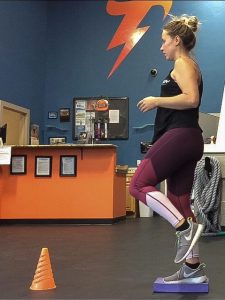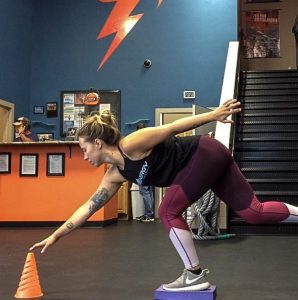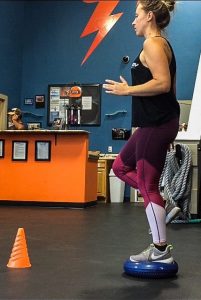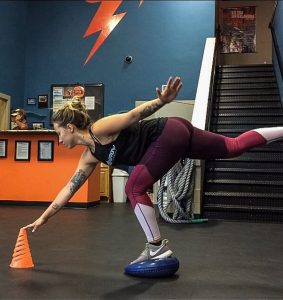Daily life brings on a multitude of unexpected forces challenging stability and balance. Missing the last step of a stairway, a loose rock on a trail, a passerby accidentally bumping one’s shoulder, and the list goes on. The ability to regain and maintain balance is essential to living a long and independent life, but is exercise and traditional balance training enough to maintain and improve balance reactions? Lower body perturbation based training may be the key to achieving the necessary neuromuscular control to prevent falls and improve overall fitness.
About 30% of adults 60 and older experience at least one fall in a given year. Falls are one of the leading causes of injury, hospitalization and, at its worst, death. Along with this, falls can result in elevated fear and anxiety, reduced independent mobility, and higher chances of being admitted to long term care facilities.
In the past, and even still, it has shown that exercise and balance training can help to reduce the risk of falls. Yet, in the last decade health and fitness professionals have been asking— is there a better way? The conclusions point to “yes”— the optimal approach may be perturbation-based balance training (PBT).
The applicable definition of perturbation is “a deviation of a system, moving object, or process, from its regular or normal state of path.” In a gym setting, the client is the moving object, and the trainer is often the perturbation.
Perturbation-based balance training is a method that applies repeated postural perturbations with the goal of improving the client’s control of rapid balance reactions. Balance reactions include compensatory steps, swaying the weight of the body, adjusting body position and reaching out for something to hold or steady oneself.
Why Perturbation Based Training?
The main difference wellness professionals are seeing between traditional balance training and PBT is the specificity. When training voluntary movements such as standing on one leg, the client is only improving their balance. This is an important quality; better balance means better body awareness and leads to less chance of losing overall stability of the body.
However, even the best balance can be lost and regaining balance becomes a focal point. Traditional approaches do not touch on this, and won’t help clients maintain, regain and/or improve their rapid balance reactions. PBT influences how the neural system recovers from a fall, for instance.
An important difference of traditional balance training and PBT, is the “unexpected”. A client that is asked to stand on one leg knows all the conditions of the situation. In PBT the client is asked to maintain proper posture and balance while repeated and unexpected perturbations are applied. This creates an unconscious training response, which improves neurological pathways and responses that kick in during real life scenarios.
All of this to say that PBT appears to reduce the risk of falls in older adults better than traditional balance work!
Keep in mind that PBT can be applied to all clients, not just older adults. Clients of all ages can benefit from improved balance and balance reactions. You might already be using these methods without realizing. Working with BOSUs, balance boards, Body Blades, and stability balls all add the element of perturbation. These tools with an unstable surface create an unexpected force, challenging the client to make neuromuscular adjustments to maintain balance and posture.
Here is an example of a perturbation-based exercise I have been using with some of my clients. This move is more on the advanced end of the progression spectrum, but can be modified.
- Balance on one foot on the foam pad or balance pad
- Reach opposite hand of standing foot towards cone
- Return to starting position


This can be made easier by using something taller than a cone. The client can also start with both feet on the foam pad or with a BOSU. Switch up the same challenge by having the client stand on the flat side and maintain balance on one foot.


Lower body perturbation training has many applications beyond preventing falls in older adults. It has been shown to be effective in pre-hab and re-hab of ankle and knee injuries and it is a great modality for athletes wanting to improve agility and joint health. Whether you’re working with the senior community or top athletes, PBT is a great way to literally shake up your training sessions.
Alex has her A.S in Exercise Science and is a certified Personal Trainer with NFPT and NSCF. She recently traveled to India to gain her 200 hr yoga teacher certification where she studied the ancient practice at its origins. Alex has spent time teaching yoga in Spain while volunteering at a yoga retreat and is currently working at her local college instructing two fitness courses. Alex wants to share with her clients and students the mental, physical and emotionally healing qualities of exercise and movement. She believes everyone should have a healthy relationship with their bodies and strives to thread that concept throughout her career.


